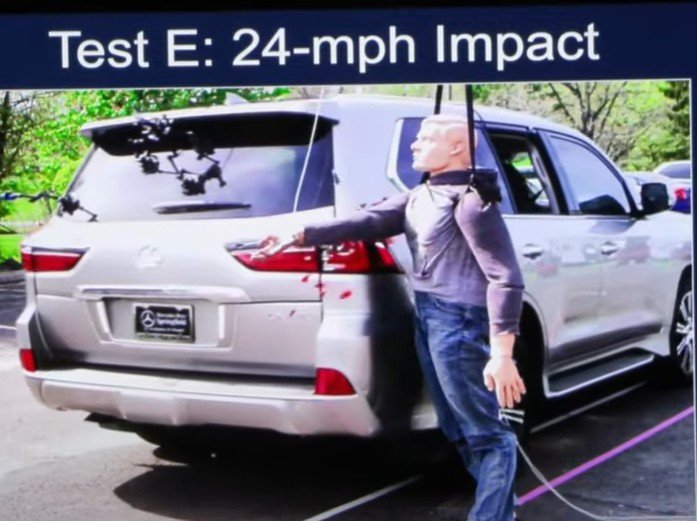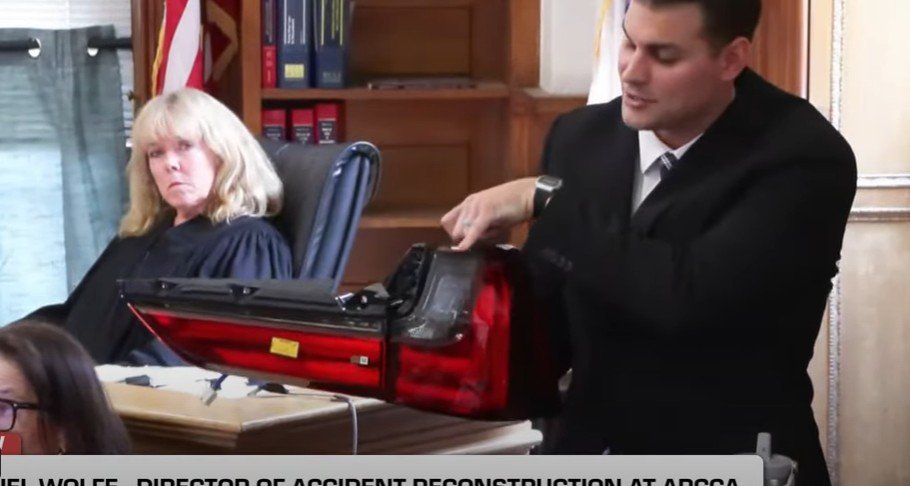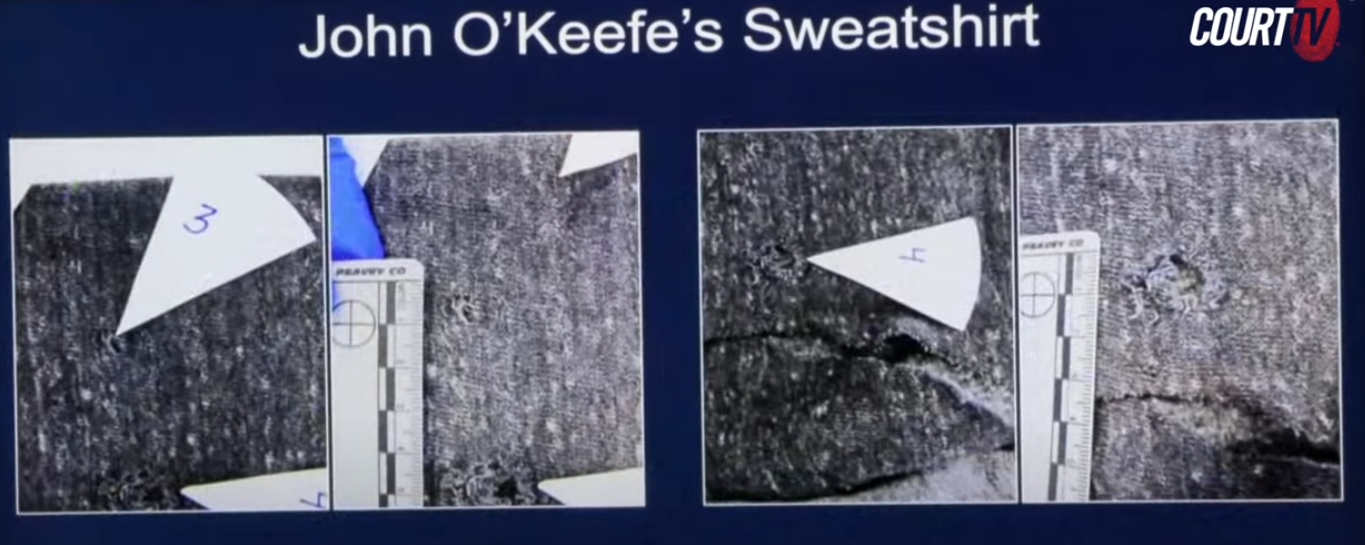
💥When a Glass or an Arm Hits Back: Dr. Wolfe’s Grand Reconstruction Debut
🎙️ Picture this: the drama is thick in a Massachusetts courtroom. Defense expert Dr. Daniel Wolfe, of ARCCA, strides in defending Karen Read—leaning heavily on a series of vehicle‑impact experiments. His mission? Show that it wasn’t John O’Keefe’s head, arm, or center mass that shattered the Lexus taillight…but perhaps a rogue cocktail glass…or something else.

Setting the Foundation: Credentials, Scope, and Sources
Karen Read’s Defense team hired accident reconstructionist experts from ARCCA. Their team is Dr. Daniel Wolfe, Dr. Andrew Rentschler, and Scott Klein.
They did not know the defense nor associated parties before involvement in the first trial. Their prior work was independent for testimony in spring/summer 2024, as they were hired by the FBI. However, the jury is not supposed to know this. Nonetheless, many hints abound regading a mysterious “other agency” not local nor state police. They were not retained but were paid by the defense approximately $10K for travel expenses and their time testifying shortly after the first trial.
Dr. Wolfe became ARCCA’s accident reconstruction director in 2024. He’s adequately qualified and you can find his academics, training and experience at ARCCA’s website.
Scope and Materials Reviewed
In preparation for the first trial, Dr. Wolfe reviewed the following materials: autopsy and crash data reports, photos, videos, Lexus vehicle data. They were to look at the evidence provided and determine whether the damage to the vehicle was consistent with the injuries to John O’Keefe. They had no predetermined theory; they developed their own. They focused on taillight damage consistency with either a cocktail glass thrown at it, or a pedestrian impact.
The cocktail glass test was performed before the first trial, and was also discussed in the second trial. ARCCA team built a pressurized cannon to simulate a glass hitting an exemplar taillight.
The 37 mph speed in which the glass projected was the sweet point and resulted in damage consistent with Lexus taillight damage. Wolfe made it clear that he did not conclude that the glass caused the damage—just that it was plausible.
Now, onto the Retrial:

The Night of Crash Dummies and Cocktail Glasses: A Courtroom Tale
The courtroom was charged with tension as defense expert Dr. Daniel Wolfe took the stand. By his own testimony, he began as ARCCA’s no-nonsense reconstructionist, uninfluenced by lawyers or media. But by his own admission, in February 2025, he reached out to the defense because of things he had heard in the media. That statement was quickly objected to by Prosecutor Brennan, and sustained and stricken by Judge Cannone.
By March 2025, reports Wolfe, he and his ARCCA team were officially hired for Trial 2. It was James Bond meets courtroom drama—except instead of relevant case files, he brought a textured pot of media optics and a brand‑new job title. They were asked to review Commonwealth expert material witness Dr. Welcher’s report and analysis.
Dr. Wolfe and his team—organic, sedan‑obsessed scientists—injected velocity (and skepticism) into a Lexus taillight. First, they renewed the presentation of the cocktail glass experiment, once again supporting the Commonwealth’s iteration that the taillight was damaged in this vehicle incident. When the chunks of taillight matched those on Karen Read’s car, Wolfe coyly noted: “Consistent… but not conclusive.”
Prosecution witness Dr. Welcher concluded that the location and orientation of the lacerations on John O’Keefe’s right forearm and arm are consistent with the geometry and orientation of the right rear tail light of Karen Reeds 2021 Lexus.
Then the real show began. Crash‑test dummies, limbs held by harness, a “Rescue Randy” manikin sans integrity, and test speeds ranging from a casual 10 mph to a ballistic 29 mph.
Wolfe staunchly proclaimed the results “inconsistent” with a pedestrian collision—even when the broken taillight looked suspiciously familiar at 24 mph. He waved away troubling variables like arm mass, free trajectory, and debris patterns with a flourish only a seasoned lawyer could love.
Let’s break it down:
Hypothesis #1 – That Mysterious Cocktail Glass
Wolfe’s crack team (including Dr. Rentschler and Klein) trialed a glass launched at 37 mph using their home-made cannon—smashing into an execmplar taillight.
Result: The experiment showed damage to the taillight consistent with the damage to Karen Read’s taillight.
Oddly, they came up with the theory independently, but they never claimed that “this exactly happened.” Just that it was scientifically plausible.
Doesn’t it seem like this test supports an incident involving a pedestrian and a vehicle? It does! So why did ARCCA present this experiment for the defense which goes against their case?
Well….because they had to. They couldn’t hide that they had conducted this experiment; it became part of the discovery and had to be shared with the prosecution team.
Reality check: Where did that glass end up in real life—still right beside John O’Keefe?
Hypothesis #2 – The Pedestrian Encounter
A multi-tiered test battery at 10, 15, 17, 24, and 29 mph, with ATD arms, Hybrid-III limbs, and even a “Rescue Randy.”
ARCCA controlled for the blizzard temperature the night of the accident by stashing equipment in chest freezers overnight, then rushed into testing while it was still frosty from the deep freeze.

The Only Test That Mattered—Until It Didn’t
The kicker: at 24 mph, the damage mirrored what’s on Karen Read’s vehicle. Still, Wolfe insisted it was inconsistent—blaming angles, harnessing, harnesses, and holy harnesses.
The two excuses for the inconsistency is that 1) there was no interior damage to the light, the diffusers, and 2) no defects were noted in the hoodie.
There are massive problems with this test however.

The Physics Classroom Fail:
Wolfe repeatedly attacked Dr. Welcher’s mere geometry alignment tests for lack of “force analysis.” Welcher made it clear why he didn’t do any actual accident reconstruction. It was because there are too many unknown variables as far as standing position.
But Wolfe’s own tests proved Dr. Welcher’s instincts were correct and had inconsistent setups:
- Arm-only vs. full body vs. hybrid setups.
- Positioning of the dummy: arm straight and outstretched; vehicle hit arm only.
- Dummy weight changes? “Doesn’t matter”…until it does matter (e.g., explaining hoodie damage).
- He didn’t track debris trajectories—yet pulled out Newton’s Laws. His mantra: “If there was no impact, why would I study trajectory?”
The Hoodie Mystery
The test sweatshirt survived 24 mph impact with no punctures. Wolfe hails this as an inconsistency.
Wolfe didn’t replicate where on the dummy those punctures might have occurred in real life…so, not exactly a slam dunk. The dummy’s arm on this test was unrealistically outstretched rather than placed in a normal human pose, and the arm hit the taillight in a different area.
As prosecution witness Dr. Welcher explained, there are simply too many variables in this type of collision scenario to expect consistent results from a single test. Each trial can produce different patterns of breakage or damage, depending on slight changes in positioning, angle, and movement. Even if you conducted the test 100 times, you might never reproduce the exact injuries or sweatshirt damage observed in this case.
One and done isn’t science—it’s speculation dressed up in lab gear.
Cross-Examination: Brennan’s Reality Check
Brennan exposes that Dr.Wolfe failed part of his certification exam (the practical exam); and lacks pedestrian-specific experience or publications.
Appeals to jury: “Didn’t you just say impact happened at night in bad weather? Yet you omitted pedestrian risk statistics that help the Commonwealth?”
In the first trial, Wolfe provided the defense scripted questions and answers after claiming not knowing anyone on the defense team.
He also used Signal, (for the first time ever), an app known for secrecy and not retaining conversation records, which was insisted upon by the defense team. Wolfe claimed that he deleted the entire conversation after the first trial, since the trial was over.
I’m just gonna go out on a limb here and assume that Dr. Wolfe heard about the mistrial, and that there would be a second trial. It’s also safe to assume he would be called for the second trial. Maybe Dr. Wolfe just doesn’t have any common sense.
He flip-flopped on the effect of arm/body mass and harnesses on damage outcomes—once dismissive, then emphatic: “Weight matters!”
The Rekindle: Dr. Welcher’s Methodology
Dr. Judson Welcher of Aperture opted not to use crash‑test dummies in his testing. Why? His goal was simple: show that limb alignment with the vehicle could cause the observed abrasions —without the complications of harnessed physics.
As he stated, he wanted clean, static geometry to build a plausible model of injury location and angle—minimizing distraction from unknown variables.
Dr. Wolfe criticized Dr. Welcher for lack of post impact trajectory in his test. However, it’s impossible to a have post impact trajectory study in Dr. Wolfe’s test due to the harness suspension of the dummy. When pedestians are hit, they aren’t dangling from ropes.

So—are Crash Test Dummies Actually Useful Here?
In a courtroom context? They can be. But…
ATD crash dummies were developed to evaluate vehicle safety systems—airbags, seat belts—not to mimic pedestrian dynamics or nuances of limb‑only impacts.
They typically represent mid‑size adult males (and only basic female/body types), not weighted, graphed, or positioned for a pedestrian.
Some experts warn that this can lead to unrealistic damage patterns in reconstruction scenarios.
Critics argue that dummies are often “too stiff”—making pedestrian-test results not align with real-world cases.
Their original inventor, Samuel Alderson, certainly built them for seatbelt and airbag testing—not arm-to-tail light torture tests.
Even ARCCA’s case study uses ATDs for things like bus‑seat impacts to judge forces the way Wolfe should have—rigorously—testing a real-world scenario
Crash test dummy results here are suggestive, not determinative. Real physics—that pesky mass × acceleration × force bit—don’t vanish because James Bond’s ATD arm is tethered or missing broken internal diffusers. As the Guardian reminds us: crash test dummies were never made to replicate a pedestrian’s ragged impact—and using them as if they were is, well, a stretch.
*** Critical Case Clue ***
🧍♂️ Rescue Randy vs. Crash Test Dummy: Not All Dummies Are Created Equal
Rescue Randy is not a crash test dummy. He’s a training mannequin—the kind EMTs use to practice dragging a “person” out of a burning building, not to simulate biomechanical trauma from a two-ton SUV.
🩹 Rescue Randy:
- Designed for rescue drills, CPR, and first responder training.
- Built to be durable, drag-able, and flexible, not anatomically or biomechanically accurate.
- No internal sensors, instrumentation, or realistic human tissue simulation.
- Basically a glorified sandbag with arms and a sad face.
🧠 Crash Test Dummies (like Hybrid III):
- Engineered to mimic human body behavior in a crash: bone density, joint articulation, tissue response.
- Packed with internal sensors that collect real-time data on force, pressure, acceleration, etc.
- Rigorously calibrated and standardized in safety testing for a reason.
🚨 Why This Matters:
Using Rescue Randy in an impact test is like using a pool noodle to measure knife sharpness. It gives you something, sure—but it’s not reliable data for injury causation.
And this wasn’t just a footnote in court—this was a point of contention. Prosecutors seized on the fact that Dr. Wolfe didn’t use a biomechanically accurate crash dummy, calling into question the validity of his entire impact reconstruction.
If you're going to claim a test shows what would or wouldn’t have caused injuries to John O’Keefe’s body, you should probably use a dummy that behaves like a body. Rescue Randy, bless his floppy soul, isn’t up to the task.

Conclusion – Courtroom Carnage, Literally
Key takeaways (briefly told):
Cocktail glass test: Confirmed physical plausibility but didn’t advance proof.
Pedestrian‑simulation tests: At 24 mph, results were eerily similar—yet Wolfe declared them not quite right due to angles, harnessing, and missing internal diffuser damage.
Dr. Wolfe overplays geometry like a playbook and then retreats when his own test setups break his argument. His criticism of Welcher’s “lack of force analysis” quickly evaporates when the courtroom draws attention to real-world complications like harness motion, debris scatter, arm mass, and actual physical data on damage.
Related Articles
Related
Judge Garnett Warns DOJ: Public Comments May Violate Court Rules in Mangione Case
New York, September 24, 2025 — In a scathing order issued today, U.S. District Judge Margaret M. Garnett ruled that officials at the Department of Justice may have breached court rules by making public statements about Luigi Mangione’s case — statements that defense...
Terrorism Charges Dropped for Luigi Mangione
On September 16, 2025, a New York judge (Gregory Carro) dismissed two terrorism‐related murder charges against Luigi Mangione. Specifically, the charges struck were: ➤First-degree murder in furtherance of terrorism under state law. ➤Second-degree murder as a crime of...
Why Karen Read’s $1.4M Prosecution Expense Is Justified
When Norfolk County released invoices showing that Karen Read’s second trial cost taxpayers more than $1.4 million, critics pounced. But is that number really excessive? Not when you compare it with other high-profile, expert-heavy prosecutions. Here’s why the expense...



0 Comments